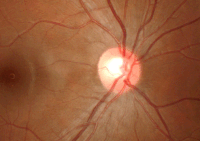
Photo from wikipedia
Background Digital optic disc photographs are integral to remote telehealth ophthalmology, yet no quality control standards exist for the brightness setting of the images. This study evaluated the relationship between… Click to show full abstract
Background Digital optic disc photographs are integral to remote telehealth ophthalmology, yet no quality control standards exist for the brightness setting of the images. This study evaluated the relationship between brightness setting and cup/disc ratio (c/d) grading among glaucoma specialists. Methods Optic disc photographs obtained during routine examinations under anesthesia were collected to construct an image library. For each optic disc, photographs were obtained at 3 light intensity settings: dark, medium, and bright. From the image library, photograph triads (dark, medium and bright) of 50 eyes (50 patients) were used to construct the study set. Nine glaucoma specialists evaluated the c/d of the study set photographs in randomized order. The relationships between the brightness levels and the c/d grading as well as graders’ years in practice and variability were evaluated. Results The c/d were graded as significantly larger in bright photographs when compared to photographs taken at the medium light intensity (0.53 vs 0.48, P < 0.001) as well as those taken at the dark setting (0.47, P < 0.001). In addition, no relationship was found between ophthalmologists’ years in practice and the variability of their c/d grading ( P = 0.76). Conclusion Image brightness affects c/d grading of nonstereoscopic disc photographs. The brighter intensity is associated with larger c/d grading. Photograph brightness may be an important factor to consider when evaluating digital disc photographs.
Journal Title: BMC Ophthalmology
Year Published: 2021
Link to full text (if available)
Share on Social Media: Sign Up to like & get
recommendations!